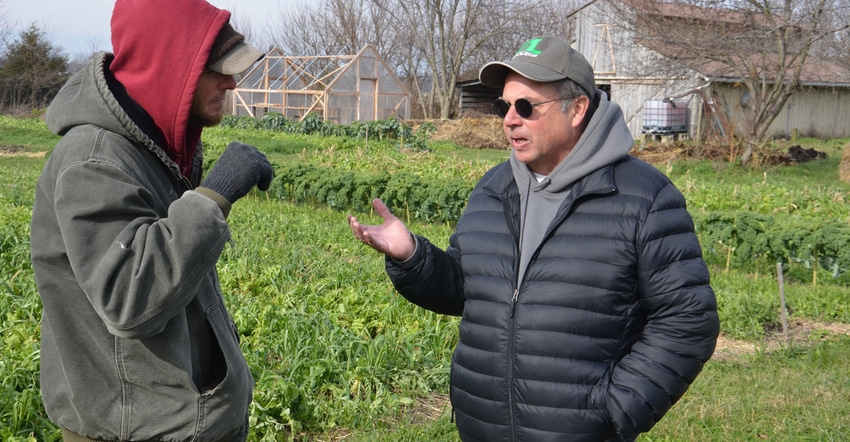December 4, 2017

They had just met each other 30 minutes earlier, and when Mike Starkey, Brownsburg, Ind., and Scott Hensley, Pittsboro, Ind., started talking about cover crops, they looked like any other two farmers who might be sharing information. The backdrop was Hensley’s cover crops.
What made this conversation unique was that on the surface, it would appear these two farmers had nothing in common. Starkey and his nephew Jeff operate a large-scale commercial grain farm, no-tilling and using cover crops as much as possible. Starkey has been involved in numerous efforts to monitor and improve water quality.
Until just over a year ago, Hensley and his wife, Erica, lived in Indianapolis. They were urban farmers. They found an opportunity to buy a very small farm in Hendricks County, and moved there just over a year ago. They raised their first crop in 2017. It was 1 acre of vegetables and flowers, with some 25 vegetables included in the mix.
This isn’t a hobby. Supplementing it with off-farm work during the off-season, this is the Hensleys’ livelihood: 1 acre of labor-intensive vegetables and flowers. And they’re already making it work.
Two farmers couldn’t seem more different or have less in common, except one thing — cover crops. That’s partly why Starkey visited the Hensley farm.
Common bond
Starkey is a soil and water conservation district supervisor in Hendricks County. “We’re very interested in supporting small farming ventures, especially those that promote soil conservation practices,” he says. “There is a place for all of us. It’s cool that Hendricks County has some unique small farms, which are serving a need. They’re supplying products to people who want local food.”
The SWCDs in Hendricks and Marion counties received a joint grant from Clean Water Indiana to support urban agriculture and small farm ventures. The project is in the first year of a three-year effort. The grant allowed the SWCDs to employ Elli Blaine full time. In addition, Marion County SWCD employs Kevin Allison to work full time advising those raising food in urban or small farm settings. Blaine and Allison often team up to offer advice to people like the Hensleys.
The Hensleys are growing cover crops on their entire acreage this winter. They acknowledge that it’s still a learning process. That’s where Hensley and Starkey found plenty to talk about. They began sharing notes on what had worked and not worked for both in various cover crop situations.
Starkey was very interested in some of the species Hensley is trying. Then the conversation turned to seeding rates of cover crops like cereal rye and annual ryegrass that Starkey uses in his operation. Hensley listened intently as Starkey explained he had discovered he could reduce seeding rates over the years and get the same performance with fewer issues.
Later, both parted as new friends, with a new respect for each other.
The message? People who earn their living from the soil will always have something in common, whether they’ve been farming 30 years or one, and whether they farm 1 acre or thousands. In this case, cover crops are the common bond. They’re helping a large commercial farm protect its resources, and helping a family with an acre of crops protect theirs as well. At the same time, both farmers agree cover crops are helping them be more productive.
You May Also Like




